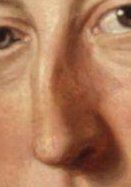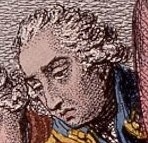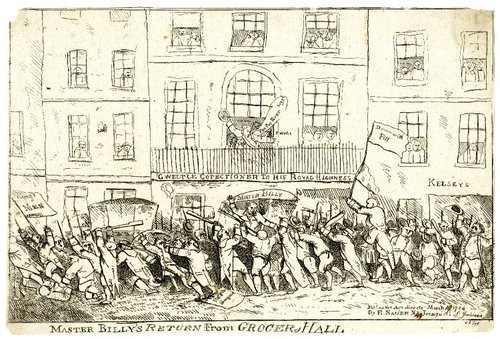Had John, 2nd Earl of Chatham been asked which year of his life was his (to coin a phrase) “Annus Horribilis”, he would very probably and with good reason have replied 1809. He might equally, however, have replied 1821, and with just as much reason.
It was not a good year. He was pushed into taking up his government at Gibraltar, a place he disliked and which very nearly killed him. His wife, who had spent most of the past two and a half years mentally ill, died suddenly in May, leaving John profoundly depressed. And a King’s Bench judgment opened a free-for-all on John’s finances, laying bare a woeful tale of debt, default, and neglect that stretched back at least forty years.
“Money? What’s that?”
John was not exceptional in this. Improvidence was a family tradition. Paying bills, to the Pitts, was something that happened to other people. Amazingly they seem to have had a very close relationship with their banker, Thomas Coutts, whom I would not have blamed for running away screaming every time he saw a Pitt family member approaching his front door. Presumably the effect of the publicity of having Lord Chatham and Mr Pitt on Coutts’ books outweighed the disadvantages incurred by their being constantly overdrawn.

Thomas Coutts, after Sir William Beechey (Wikimedia Commons)
John had long been notorious for his money problems. Wraxall spoke of “his total want of economy” in his memoirs, and there were rumours he had only been appointed commander-in-chief of the 1809 Walcheren expedition because of his straitened finances.[1] He definitely loved pomp and luxury, and his lifestyle as a peer of the realm was a costly one. Here’s a description of a new carriage he had made in January 1801:[2]

Swish, and no doubt expensive too.
“Debts contracted at play”?
Of course there’s a distinct possibility that John’s financial problems were not simply due to extravagance. Unlike his brother William, John may have been a keen gambler. To be honest I’ve not found any direct evidence of this, but it’s a possibility, and there are some hints. He definitely had an interest in horse racing, no doubt encouraged by his living at Cheveley Park near Newmarket for ten years. I’ve spotted him eyeing up a horse put up for sale by the Duke of Portland in 1780, and his wife definitely had a horse running at least one year for money:[3]

It wasn’t just horse racing, though. In 1793 John was rumoured “to sit up all night at a club”, and presumably this involved gambling.[4] In 1844 Cyrus Redding published “Recollections of the Author of Vathek“, that is to say William Beckford, who had spent his formative years with the Pitt children and informed his biographer that John had sold his father’s house of Burton Pynsent “to pay debts contracted at play”.[5] Interesting theory, although in fairness to John there were other demands on the estate forcing him to sell.
Most damning of all was the judgment of his step-nephew, James Stanhope. Stanhope visited Burton Pynsent, some years after John sold it, and was moved to write a bitter poem on the subject of his uncles’ comparative inheritances:
The immortal Chatham ee’r [sic] he died
These gifts he thus assigned
Take then my fortune John, he cried
Thou William hast my mind[.]
This son the Part improved with toil
That ’twas his Countrys weal;
The former Burton learnt to spoil
To shuffle, cut, and deal.”[6]
*cringe*
James Stanhope may have been a little unjust. Even if John was a gambling man, the “fortune” he inherited wasn’t much cop. Yes, Parliament settled a pension of £4000 on the Chatham earldom after Pitt the Elder’s death in 1778, and in 1803 John became the “third life” to hold the £3000 pension settled on his father for three lives in the 1760s, but the latter was hardly ever paid and the former barely offset the long-term effect of Pitt the Elder’s own spendthriftiness.
John’s inheritance
![William Pitt the Elder, 1st Earl of Chatham by William Hoare (Wikimedia Commons) [b]](https://alwayswantedtobeareiter.files.wordpress.com/2014/10/471px-williampitttheelder.jpg?w=236&h=300)
William Pitt the Elder, 1st Earl of Chatham by William Hoare (Wikimedia Commons) [b]
Pitt the Elder just didn’t give a damn. Not the slightest. He would quite happily borrow huge sums of money off family and friends– £10,000 in one go in 1777, for example– without the faintest intention of paying it back.[7] (His wife tried her best, but since she was never able to stop her husband spending it must have been like holding back the tide.) Both the properties John inherited, Hayes Place in Kent and Burton Pynsent, were heavily mortgaged: Burton for over £13,000, Hayes for £10,000. Burton supposedly brought in £3000 a year, but this was rarely realised and, in any case, barely paid for the upkeep of the estate itself. It did not help that all three of the younger Pitt children had been assigned various sums in their father’s will, to which they were entitled on the security of the mortgages taken out on the two properties.[8]
In short, when John inherited the estate, his “fortune” consisted almost entirely of debts. The £4000 pension attached to the earldom was the only thing standing between him and utter penury: it was a good sum, but without lands to back it up, did little but allow the Earl of Chatham to live according to his rank.
The shock, therefore, is that Burton Pynsent remained so long in Pitt family hands, gambling debts or no. John sold Hayes in May 1785 to Sir James Bond (… no, not that one) for £8540, which didn’t even cover the mortgage. Even so, the funds were divided between members of the Pitt family (William, for example, received just under £4400).[9] His mother used Burton Pynsent as a dower-house until her death in April 1803, but even as early as February 1803 John was clearly getting itchy: he had the farms and lands valued, clearly with the intention of selling as soon as possible.[10] He finally managed to sell it in 1805, and became officially “landless”.
Fire your accountant, John
Small wonder, then, that John was so much in debt. He and his brother William started early, and often together. In December 1780 (around the same time, in fact, that John was eyeing up the Duke of Portland’s racing horse) they jointly paid a lump sum of £3500 to the Duke of Rutland in return for an annuity of £300 derived from three of Rutland’s Cambridgeshire estates. (John rather cavalierly countersigned the agreement from Newmarket, where he was hunting at the time.)[11] This lump sum was acquired partly through two separate loans for £1500, secured on two chamber sets at Lincoln’s Inn belonging jointly to William and John (the sets themselves were purchased with at least two separate loans).[12] Yes, you read that right: a loan secured on a loan, to pay for a loan.
 In 1785 John was at it again, borrowing a total of £3150 from three separate moneylenders. In the 1790s John and William again jointly borrowed two separate sums of £6000 and £7000 from Coutts, the first through his bank and the second on a private basis. At least John seems to have paid most of the second loan back in 1804.[13]
In 1785 John was at it again, borrowing a total of £3150 from three separate moneylenders. In the 1790s John and William again jointly borrowed two separate sums of £6000 and £7000 from Coutts, the first through his bank and the second on a private basis. At least John seems to have paid most of the second loan back in 1804.[13]
And this is presumably only skimming the surface: like his father, John was quite happy to accept money from whoever was willing to give it, although I’d like to think he had a *leeeeetle* more of an intention of paying it back. His official cabinet salary, which he received 1788-1806 and 1807-10, did not make much difference to his borrowing habits. He borrowed money from his (himself heavily indebted) brother William, and entered into a number of bonds with his friend Lord Camden: one in October 1797 for £1500 at 5%, and one in 1806 for £4000, also at 5%. All these loans were secured on the same source (and anyway John had no property by 1806): the £4000 Chatham Earldom pension, itself already signed over a thousand times over to Thomas Coutts, the fashionable moneylenders the Goldsmid brothers, and others.[14]

Abraham Goldsmid, one of Lord Chatham’s many moneylenders (Wikimedia Commons)
Small wonder, then, that when John was out of office in 1806 he had to resort to selling off a selection of his father and brother’s books:[15]

At this point I must stop before I beat my head against the desk so often I lose consciousness, but it’s literally a flavour of what was going on, not a comprehensive list.
The King’s Bench Judgment
Astoundingly, nothing much seems to have come of all this borrowing and mortgaging and shifting until sometime in late 1820 when John finally found a creditor who put his foot down and demanded his money back. It must have come as a shock, particularly when the man dragged John to court– especially when John lost.

Court of King’s Bench in the 19th century (Wikimedia Commons)
I’m not clear on the details, as I haven’t managed to find the court case in question, but it seems John borrowed £8126 from Mr John Burke. I’m not clear on who Mr Burke was, but what he was was determined, and when he discovered John did not have the means to pay him back, he sued. The resulting King’s Bench judgment clearly required John to pay Burke appropriate damages, in default of which the bailiffs would be sent in to seize his property. As a cherry on the cake, John was also required to pay Burke’s legal costs.[16]
Needless to say, John did not have the ready money. He had not had a government salary since 1810, although he did have his emoluments as Governor of Jersey, High Steward of Colchester (till 1817), and Colonel of the 4th Regiment of Foot. Still, his wife had been constantly ill for two years: whatever ready cash he had, presumably, had mostly gone on her healthcare. In January 1820 John had been made Governor of Gibraltar, with a salary of £2800, and perhaps it was this circumstance that inspired Burke to try his luck.[17]
To avoid the embarrassment of the bailiffs, John had no choice but to negotiate. His agent, Joseph Ward, met with Burke’s agent, Francis Robertson, and hammered out a compromise. The result was a bond, signed 11 January 1821:
Whereas the said John Earl of Chatham hath contracted and agreed with the said John Burke for the absolute sale to him the said John Burke of One Annuity or clear yearly Sum of Six hundred and ninety one pounds two shillings and six pence to be paid to the said John Burke his Executors Administrators and Assigns during the natural life of the said John Earl of Chatham…
The money was due to be raised from the poor £4000 pension attached to the Chatham earldom, already mortgaged in all directions beyond its ability to bear. This time, however, John was caught coming and going: if he defaulted on his quarterly payments by 28 days, in went the bailiffs, out came his pretty furniture.[18]
At some point after this date, however, Burke remembered that there were further damages to consider, because the money Chatham had borrowed had been raised from selling the £10,000 worth of stock Burke’s wife, Louisa Angelo Tremamondo, had brought as her dowry. The £600 annuity was therefore raised to £1196, and the money claimed in damages to £13,075.[19] Possibly this was due to interest, but it does not appear to be a separate agreement.
I cannot imagine the face John made when he put his pen to that bond, but sign it he did.
…. And it just keeps getting worse
So what did John do to finance his brand spanking new debt? You guessed it. He took out three life insurance policies, with three insurance companies: one with the Fire and Life Insurance Company for a total of £5000, one with the Provident Institution for £1800, and one with the Union Life Office for £400. A total of £7200 to be paid on his death to Joseph Ward, who would presumably then turn the proceeds over to Burke and clear the debt.[20]
Unluckily for Burke, he did not live long enough to benefit from the arrangement and died in December 1824. John, however, didn’t benefit either: he was bound to continue his quarterly payments to Burke’s “Executors Administrators and Assigns” during the term of his “natural life”, which meant continuing payments to Burke’s widow Louisa. Mrs Burke, therefore, received nearly eleven years’ worth of payments of £1196– about £13,000 in all. She received her last payment of £336 in October 1835 from John’s executors.[21]
Open season!
At around this time– probably not coincidentally– the husband of John’s niece, Harriot Hester, suddenly remembered something VERY important.
Sir William Pringle had married Harriot Hester Eliot, only daughter of John’s sister Harriot, in May 1806. Harriot Hester had lived for two and a half years with her aunt and uncle in London and remained close to the Chathams. Although there had been issues with her marriage to Pringle– John seems to have considered the man, who was fifteen years older than Harriot Hester, to be a fortune hunter– the couple were always welcome at John’s house, and Sir William and John frequently went hunting together.[22]
In February 1821, though, Sir William Pringle wrote to George Pretyman-Tomline to express concern about the terms of his wife’s fifteen-year-old marriage contract. By the terms of her marriage contract, Harriot Hester was due £3795 plus interest, which was to have been her mother’s “portion” or dowry, a sum that had not become fully available until Burton Pynsent was sold in 1805.[23] By 1821 this sum had not yet been paid, and Sir William wrote to ask Tomline to press Lord Chatham on the matter as Pringle’s solicitor had advised him to open a case of “culpable neglect”.[24]
I find it very hard to believe that Sir William Pringle had spent fifteen years not noticing that his wife (who was, incidentally, worth a vast amount of money, both in terms of property and ready cash– well over £10,000 in fact) was owed a whisker under £4000. I strongly suspect he chose February 1821 to press the point, because his solicitor reminded him there was now a precedent of Lord Chatham being taken to the legal cleaners and scrubbed till it damn well hurt.
Again, Chatham had no money; again, he had no choice. His solution was wearingly familiar, as Pringle informed Tomline: Chatham had proposed to secure
the reversion of the produce of the Burton Pynsent Estate to Lady Pringle & her Children, by assigning to trustees two policies of insurance on his life made at the Equitable Insurance Office, which are valued at £11,000, & by vesting the remainder of the money [from Burton Pynsent] in trustees, so that at his death the sum of about £16,000 would be forth coming to those entitled to it.
This arrangement tho’ certainly not so satisfactory as if the whole money had been vested, Lady Pringle & I have as far as we are concer’d, acceded to, from having been advised so to do, by our Solicitors & from being informed, & having every reason to believe, it was the best & indeed the only security Lord Chatham had to give.[25]
I imagine hunting visits at Lord Chatham’s house were rather more strained after this.
And yet…
The events of 1821 seem to have been a caution to John. He did take out at least one more life insurance policy on behalf of his other heir, William Stanhope Taylor, grandson of John’s sister Hester, and on John’s death at least one of the life insurance policies remained unpaid because John had (unsurprisingly) failed to keep up his annual payments, but all in all he seems to have behaved himself.[26]
He lived much more simply than he had done, renting a house in Brighton and mortgaging a (comparatively modest-sized) house in Charles Street. When he expired in that house on 24 September 1835, his heirs sold everything they could– even the servants’ bedlinen– but they balanced the books within a month.[27]

In the end, the “improvident Lord Chatham” was virtually the only member of his family to die solvent.
References
[1] Sir Nathaniel Wraxall, Posthumous Memoirs of my Own Time, III (London, 1836), 130; H.B. Robinson, Memoirs of Sir Thomas Picton, I (London, 1836), 231
[2] Morning Post, 20 Jan 1801
[3] Edward Thoroton Gould to the Duke of Portland, 27 Nov 1780, Nottingham University Archive Portland MSS PwF 4.284; Times, 26 March 1788
[4] Sir Gilbert Elliot’s diary, 11 September 1793, quoted in Paul Kelly, “Strategy and Counter-Revolution: the Journal of Sir Gilbert Elliot, 1-22 September 1793”, EHR 98 (387) April 1974 328-348, 342
[5] Cyrus Redding, “Recollections of the Author of Vathek“, printed in The New Monthly Magazine 71 (2) 1844, 302
[6] Dacre Adams MSS, British Library Add MSS 89036/2/4 f 101
[7] Stanley Ayling, The Elder Pitt, Earl of Chatham (London, 1976), p 406
[8] John Ehrman (Ehrman I), The Younger Pitt: The Years of Acclaim (London, 1969), p. 19
[9] Ehrman I, 19
[10] National Archives Chatham MSS PRO 30/8/371 f 158
[11] Ehrman I, 20; the bond is dated 1 December 1780 and is at Ipswich RO, Pretyman MSS, HA 119/4/4/9/3/2
[12] Ehrman I, 20
[13] Tresham Lever, The House of Pitt (London, 1947), p. 359; Ehrman I, 601-2, 602 n 1
[14] Bond between Chatham and Camden, 3 October 1797, Kent RO Camden MSS CKS-U840/E20; bond between Chatham and Camden, 24 June 1806, Kent RO Camden MSS CKS-U840/E21; and National Archives Chatham MSS PRO 30/8/371 for the deeds mortgaging the Chatham pension
[15] Morning Post, 25 December 1806
[16] Bond between the Earl of Chatham, John Burke and Joseph Ward, 11 January 1821, National Archives Chatham MSS PRO 30/8/370 f 183
[17] Report from the select committee on the colonial military expenditure… (London, 1834) VI, 7
[18] Bond between the Earl of Chatham, John Burke and Joseph Ward, 11 January 1821, National Archives Chatham MSS PRO 30/8/370 f 183
[19] Bond between Francis Robertson and Louisa Angelo Burke, 17 June 1828, National Archives Chatham MSS PRO 30/8/370 f 238
[20] Bond between Francis Robertson and Louisa Angelo Burke, 17 June 1828, National Archives Chatham MSS PRO 30/8/370 f 238
[21] National Archives Chatham MSS PRO 30/8/370 f 152
[22] Chatham to George Pretyman-Tomline, 22 September 1819; Chatham to George Pretyman-Tomline, 19 January 1820, Ipswich RO Pretyman MSS HA 119/562/688
[23] Marriage settlement of Harriot Hester Eliot and William Pringle, 16 May 1806, Cornwall RO EL/647. I am grateful to Stephenie Woolterton for putting this document my way
[24] Sir William Pringle to George Pretyman-Tomline, 12 February 1821; William Eliot to George Pretyman-Tomline, 5 March 1821, Ipswich RO Pretyman MSS HA/119/562/688
[25] Sir William Pringle to George Pretyman-Tomline, 27 April 1821, Ipswich RO Pretyman MSS HA 119/562/688
[26] Life insurance policy dated 17 August 1833, National Archives Chatham MSS PRO 30/8/370 f 89
[27] Times, 10 Nov 1835













![William Pitt the Elder, 1st Earl of Chatham by William Hoare (Wikimedia Commons) [b]](https://alwayswantedtobeareiter.files.wordpress.com/2014/10/471px-williampitttheelder.jpg?w=236&h=300)





















